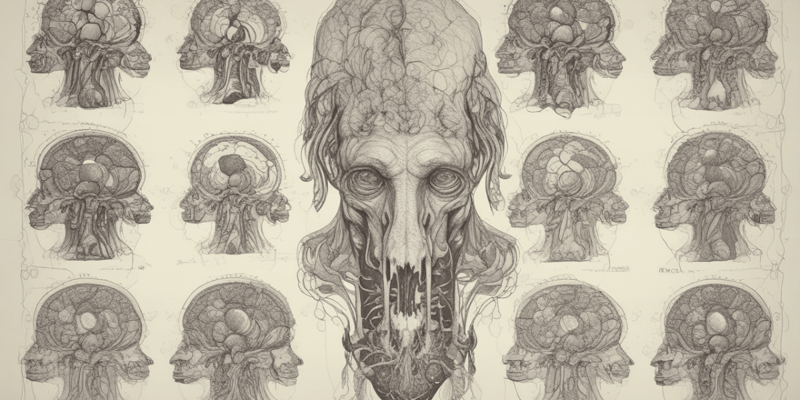Podcast Beta
Questions and Answers
What is a pidgin?
What is the main difference between a pidgin and a creole?
What is specific language impairment (SLI)?
What is the role of the FOXP2 gene in language development?
Signup and view all the answers
What is the relationship between language abilities and the brain?
Signup and view all the answers
What is the evidence for the natural selection of language abilities?
Signup and view all the answers
What is the proposed first step in the evolution of language?
Signup and view all the answers
What type of research could provide further insight into the relationship between genetic factors, selective pressures, and the emergence of language?
Signup and view all the answers
What is the significance of Broca's area and Wernicke's area in language development?
Signup and view all the answers
Study Notes
Evolutionary Psychology
- Evolutionary psychology (EP) is the study of the evolutionary biology of mind, brain, and behavior.
- It synthesizes evolutionary biology, biological anthropology, psychology, and cognitive neuroscience.
- EP is not a subfield of psychology, but a different approach to the entire field.
Adaptive Evolution
- Adaptive evolution is a special kind of change caused by natural selection.
- It builds adaptations, which are constrained by heritability.
- Adaptations are traits that exist because they contributed to reproduction in ancestral populations.
Infanticide in Animals
- Infanticide, the killing of infants, is a reproductive strategy in some species.
- In common langurs, males that take over a group kill the infants to bring the females into heat, allowing them to mate.
- This behavior is an adaptation that increases the male's reproductive success.
Natural Selection
- Natural selection is the process that drives adaptive evolution.
- It is the differential reproduction of heritable elements due to better or worse fit with the environment.
- Natural selection builds adaptations that are good for the gene, not the species, group, or individual.
Prerequisites for Evolution by Natural Selection
- Variation in a trait
- The trait is sufficiently heritable
- The trait affects its own rate of replication
- A quantitative relationship between the above two factors
Evolutionary Biology
- Evolution builds "designs for reproduction" that are good for the gene.
- Evolutionary biology focuses on the ultimate causes of behavior, not just the proximate mechanisms.
Facultative Traits
- Facultative traits are adaptations that respond to specific environmental cues.
- Examples include suntanning, resource-dependent growth, and light-dependent pupil size.
- Facultative traits are not simply a result of genes or environment, but an interaction between the two.
Evolutionary Psychology vs. Traditional Psychology
- EP differs from traditional psychology in its focus on ultimate causes and adaptation.
- EP challenges the Standard Social Science Model (SSSM), which views the human mind as a blank slate shaped by experience.
- EP argues that human behavior is shaped by a large collection of specialized modules built by natural selection.
Behavioral Genetics
- Behavioral genetics studies the genetic basis of behavioral traits.
- The central concept in behavioral genetics is heritability, which is the proportion of phenotypic variation due to genetic differences.
- Heritability provides an estimate of how much of a trait is due to genetic factors.
Critique of the Standard Social Science Model (SSSM)
- The SSSM views the human mind as a blank slate shaped by experience.
- EP argues that the human mind is not a blank slate, but rather a collection of specialized modules built by natural selection.
- The SSSM separates natural and social sciences, whereas EP views psychology as a part of biology.
- The SSSM lacks an overarching theory of design, ignoring adaptation and the force of natural selection.### Natural Disasters and Genes
- Natural disasters like tornadoes, hurricanes, earthquakes, and volcanic eruptions are complex events that scientists try to understand to predict and prepare for them.
- Genes can be thought of as having "consciousness" and making decisions, but this is a humanized concept and genes do not have a mind or brain.
- Genes encode programs, similar to computer programs, and make decisions based on their programming.
Music and Human Behavior
- Music is a human universal, a common aspect of human culture across different societies.
- Music may have evolved to facilitate social coordination and cooperation.
- It is a complex behavior that serves various functions, including expressing emotions, conveying information, and facilitating group bonding.
Psychological Traits as Adaptations
- Psychological traits, such as behaviors and emotions, are shaped by natural selection to enhance fitness in ancestral environments.
- These traits are specialized, domain-specific, and preserved by selection because of their contribution to fitness.
- They are formed cumulatively by the selective retention of favorable mutations.
Sensation and Perception
- Sensation and perception are adaptations that have evolved to guide behavior in response to environmental stimuli.
- They are specialized to handle specific types of input, such as light, sound, and chemicals.
- Examples of adaptations include vision, hearing, smell, taste, and touch, each with its own unique mechanisms.
Bat Sonar
- Bats use echolocation to navigate and hunt in the dark.
- They emit high-frequency sounds, which are beyond human hearing, and use their large ears to detect the echoes.
- This adaptation allows them to build a mental map of their environment and locate prey.
Learning and Conditioning
- Learning is the modification of behavior based on experience.
- There are different types of learning, including classical and operant conditioning.
- Classical conditioning involves associating stimuli with consequences, while operant conditioning involves modifying behavior based on its consequences.
Language as an Adaptation
-
Language is a complex adaptation that has evolved to facilitate communication among humans.
-
It is not just a byproduct of other adaptations, such as a large brain or social learning.
-
Language has its own unique design features, including phonemes, morphemes, and grammar, which are universal across human languages.
-
The evolution of language is supported by the existence of language-related brain structures and the costs associated with language, such as the risk of choking.### Language as an Adaptation
-
Mastery of spoken language is a human universal, unlike other kinds of mastery like farming, flying an airplane, or playing chess.
-
All languages have phonemes, morphemes, morphophonemic rules, morphology, and syntax, which interact in similar ways, making it possible for kids to learn any language.
Language Development in Children
- Children follow a regular pattern of language development across childhood, deducing rules at all levels (phonemes, morphemes, morphophonemic, morphology, and syntax) without being explicitly taught.
- By around five years old, children can correctly produce sentences they have never heard before, showing mastery of language rules.
- Overgeneralization, such as saying "We goed" or "She buyed", is evidence that kids deduce these rules rather than copying.
Pidgins and Creoles
- A pidgin is a grammatically and morphemically impoverished communication system that develops when speakers of different languages interact.
- Children convert pidgins into creoles, which have all the features of a full language, by deducing the rules of language.
Language and General Intelligence
- Specific Language Impairment (SLI) is a language difficulty unrelated to deficits in hearing, oral-motor development, or general intelligence, and is heritable with associated genetic mutations (e.g., FOXP2).
- Williams syndrome patients, with very low general intelligence, develop language normally, showing a double dissociation with general intelligence.
Evolution of Language
- Evidence suggests recent selection for genes associated with language ability.
- Language abilities are localized to specific brain areas (e.g., Broca's area, Wernicke's area), and damage to these areas can impair language abilities without affecting other cognitive skills.
Origins of Language
- The beginning of language is difficult to imagine, as it is hard to conceive of a time when language rules and abilities did not exist.
- The process of language evolution must have been cumulative, with each step being beneficial, otherwise, natural selection would have eliminated it.
Future Research Directions
- GWAS studies of specific language impairments combined with ancient-DNA studies comparing modern and ancestral populations could provide further insight into the relationship between genetic factors, selective pressures, and the emergence of language in human evolution.
- Investigating the relationship between evolutionary psychology and language development could help explain the development of personality in individuals.
Studying That Suits You
Use AI to generate personalized quizzes and flashcards to suit your learning preferences.
Description
Introduction to Evolutionary Psychology, exploring the intersection of evolutionary biology, anthropology, and psychology to understand the mind, brain, and behavior.




